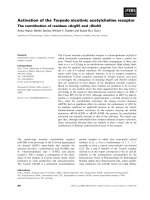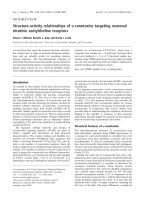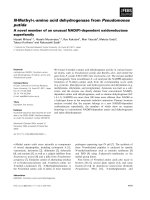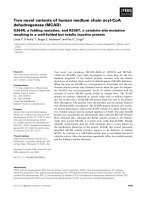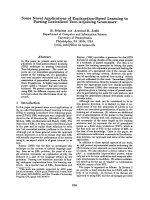O NEUROTOXINS NOVEL ANTAGONISTS OF NICOTINIC ACETYLCHOLINE RECEPTORS FROM SNAKE VENOM
Bạn đang xem bản rút gọn của tài liệu. Xem và tải ngay bản đầy đủ của tài liệu tại đây (4.93 MB, 202 trang )
Ω-NEUROTOXINS: NOVEL ANTAGONISTS OF
NICOTINIC ACETYLCHOLINE RECEPTORS FROM
SNAKE VENOM
VARUNA H. P
(M.Sc. (Biochemistry))
A THESIS SUBMITTED FOR THE DEGREE OF
DOCTOR OF PHILOSOPHY
DEPARTMENT OF BIOLOGICAL SCIENCES
FACULTY OF SCIENCE
NATIONAL UNIVERSITY OF SINGAPORE
JANUARY 2015
DECLARATION
I hereby declare that this thesis is my original work and it has been written by
me in its entirety. I have duly acknowledged all the sources of information
which have been used in the thesis.
This thesis has also not been submitted for any degree in any university
previously.
Varuna H P
20thJanuary 2105
i
Acknowledgements
To begin with, I would like to thank the almighty for bestowing me with
strength to tackle failures and persistence to learn from them.
I feel privileged to be supervised by Professor R Manjunatha Kini, who was
not only a patient teacher but an inspiration. I am thankful for his aspiring
guidance, invaluably constructive criticism and friendly advice during the
course of my research. He has a great role in fine tuning my presentation
skills, writing skills as well as my scientific thought process. I would also like
to thank him for providing me an opportunity to learn at various labs both in
Singapore and during overseas attachments, which was a great deal of
exposure for me to grow as a confident and independent researcher.
I would like to express my sincere gratitude towards Professor David J.
Adams, RMIT, Melbourne, Australia, for opening his lab doors for me to
learn, conduct and discuss electrophysiology experiments. I would like to
thank Professor Adam’s group members, Dr Fe Abogadie, Dr Hartmut Cuny,
Dr Peter Bartels, Joshua Ross Lawson, Dr Geza Berecki, Dr Han Shen Tea, Dr
Shiva Nag and Dr Mahsa Sadeghi who have helped me in one way or the other
during my stay at RMIT. I owe a great debt of gratitude to Dr Shiva Nag, who
has helped me patiently with my experiments and was always available for
discussions. I am thankful to Dr Han Shen Tea, who was a joyful neighbour
and dependable senior for scientific discussions in the lab.
I would like to thank Professor J. Sivaraman and his lab member, Dr
Jobichen for being available to advice on the crystallisation studies of Oh9-1. I
ii
would like to thank Professor Peter Wong and his group members, Mrs Ting
Wee Lee and Ms Su Jing for helping me with various aspects of pharmacology
experiments.
I am grateful to Professor Cletus D’Souza, who believed in me and has
guided me through my tough times. I would also like to thank Professor B. S
Vishwanath, Professor Karun Kumar, Dr K. Kemparaju, Dr Gopal Marathe
and Dr K. S Girish for being such wonderful teachers.
I would like to thank all the past and present lab members of Protein
Science lab, Dr Ryan McCleary, Dr Aktar Chouduri, Dr Guna Shekhar, Dr
Amrita Roy, Dr Vallerinteavide Mavelli Girish, Dr Tan Wei Ling Angelina, Dr
Bhaskar Barnwal, Dr Sindhuja Shirdharan, Dr Foo Chun Shin, Dr Guillaume
Blanchet, Dr Saravanan Vivekanandan, Aldo, Ritu Chandna, Bidhan Chandra
Nayak, Summer, Iyer Janaki Krishnamoorthy, Ben Wong and Norrapat Shih
for providing a professional lab environment for me to learn and develop as an
independent professional in research. My special thanks to Dr Guillaume for
advising me on various aspects of my thesis and explaining me about
phylogeny studies. I would like to thank Stuart, Dr Foo Chun Shin and Ritu
Chandna for initially teaching me CBCM experiments. I extend my gratitude
to Dr Ryan McCleary for being supportive and boosting confidence in me at
difficult times. I owe a great deal of gratitude to Ritu Chandna, who was not
only an awesome friend but an invaluable senior for me. She was my moral
support, my escape destination for all the research related road-blocks and a
jovial friend in and outside the lab throughout my Ph.D. I thank you Ritu
Chandna, for always being there, which meant a lot to me.
iii
I extend my gratitude to all the members of Structural Biology Labs I-V
who have helped me in my lab work both by lending chemicals whenever I
used to run out of them and by co-operating with space in the common
facilities, especially in the cold room.
I am grateful to NUS graduate research scholarship program, for the
financial support during my Ph.D. I sincerely thank Bee Ling and Xu Liyuan,
who were always a mail away for all the purchases and management in the lab.
Thank you for your support and in time responses. I would like to thank Mrs
Reena, Mrs Priscilla, Mrs Chan and all the staff of Department of Biological
Sciences, who have helped me with various aspects of my stay at NUS. Thank
you all for your patience and support.
Most importantly, none of this could have happened without my family.
My Dad (H. K Puttaswamy Gowda), who is more a friend to me and has
always, offered his encouragement and blessings. My Mom (M.K Tulsi Devi),
who taught me as much as she could in 12 years of our togetherness, which
has always guided and protected me, in her absence. My heartfelt thanks to
my brother Panish H P, dearest friend Kouser and all Abhivyakthians, my
well-wishers Renuka aunty, Sadhana and Sharath - every time I had doubts,
you guys were always there encouraging me beyond my doubts. I am forever
grateful for that. I am also thankful to my parents-in-law, Mr Ramaiah V and
Mrs Yashoda Ramaiah, my sister-in-law, Indumukhi and the little one of the
family, Arna, for their constant love and encouragement. I sincerely thank my
brother-in-law, Dr C.M Chandrashekar, Assistant Professor, Homi Bhaba
National Institute, India, for helping me proof-read my thesis. I am extremely
iv
thankful to my husband, Dr Pramodh Ramaiah, Physician, Transocean Oil and
Gas Corporation; for his support, patience and active participation in scientific
discussions. His witty suggestions on various experiments have helped me in
achieving time-effectiveness with less labour. This thesis stands as a testament
to my family’s unconditional love and encouragement.
Finally, I am using this opportunity to express my gratitude to everyone
who supported me throughout the course of Ph.D.
Varuna H P
January, 2015.
v
Table of contents
DECLARATION ....................................................................................... i
Acknowledgements ...................................................................................ii
Table of contents ...................................................................................... vi
Summary ................................................................................................xiii
RESEARCH COLLABORATIONS ...................................................... xvi
ACADEMIC CONFERENCES AND PRESENTATIONS………….xviii
List of Tables ........................................................................................xviii
List of Figures ........................................................................................ xix
Abbreviations ........................................................................................ xxii
CHAPTER 1: INTRODUCTION ........................................................................... 1
1.1 Venom research: A paradigm shift...................................................... 2
1.2 Snakes: Venomous and non-venomous slithering serpents ................ 5
1.3 Snake venom: Deadly cocktail of multifaceted components .............. 6
1.3.1. Enzymatic snake venom proteins .............................................. 7
1.3.2. Non-enzymatic proteins ............................................................. 8
1.4 Three-finger toxin family (3FTx) ...................................................... 10
vi
1.5 Three-finger neurotoxins ................................................................... 15
1.5.1 Curaremimetic toxins (α-neurotoxins) ...................................... 16
1.5.2 κ-neurotoxins and other dimeric three-finger neurotoxins; ...... 19
1.6 α-Neurotoxins: Delineation of molecular determinants .................... 20
1.7 Nicotinic acetylcholine receptors (nAChRs)..................................... 29
1.7.1 Muscle type nAChRs ................................................................ 35
1.7.2 Neuronal nicotinic acetylcholine receptors............................... 35
1.7.3 Significance of nAChRs ........................................................... 37
1.8 Ligands and ligand binding site of nAChRs ..................................... 38
Agonists and agonist binding site: ..................................................... 38
Antagonists and their binding sites: ................................................... 41
1.9 Antiquity of nAChRs: defined by predator-prey relationships ......... 43
1.10 Rationale and Aims ......................................................................... 46
1.10.1 Rationale: in the scope of nAChRs ......................................... 46
1.10.2 Rationale: in the scope of snake venom research ................... 47
1.10.3 Aims: specific aims................................................................. 48
vii
CHAPTER 2: CHARACTERIZATION OF STRUCTURE , FUNCTION OF Oh9-1 ..... 52
2.1 Introduction ....................................................................................... 53
2.2 Materials and Methods ...................................................................... 55
Cloning of Oh9-1 gene into pET-22b vector ..................................... 57
Transformation of clone and expression host strains......................... 58
Plasmid DNA isolation ...................................................................... 58
DNA sequencing and analysis ........................................................... 59
Protein expression .............................................................................. 60
Preparation and solubilisation of inclusion bodies ............................ 61
Preparing samples for PAGE ............................................................. 62
Sodium dodecyl sulphate – polyacrylamide gel electrophoresis ....... 63
Reduction of solubilised inclusion bodies ......................................... 64
Protein purification on RP-HPLC ...................................................... 64
Molecular mass determination ........................................................... 64
Refolding of protein ........................................................................... 65
Gel filtration chromatography ........................................................... 66
Circular dichroism (CD) spectroscopy .............................................. 67
viii
Ex vivo Organ bath experiments ........................................................ 67
Electrophysiological studies .............................................................. 72
Radioligand binding assay with AChBP ........................................... 72
2.3 Results ............................................................................................. 828
2.3.1 Production of Oh9-1 ..................................................................... 782
Cloning synthetic gene of Oh9-1 ....................................................... 78
Recombinant expression of Oh9-1 .................................................. 830
RP-HPLC purification of denatured and reduced Oh9-1................... 83
Refolding and RP-HPLC purification refolded Oh9-1 ...................... 83
2.3.2 Functional characterisation of Oh9-1 ............................................ 82
Ex vivo organ bath experiments using isolated CBCM ................... 834
Electrophysiological studies of Oh9-1 ............................................... 83
a) Subtype selectivity and concentration-responses of Oh9-1 ........... 84
b) Competitive binding studies of Oh9-1 .......................................... 86
Radioligand binding assay with acetylcholine binding protein ......... 90
2.3.3 Structural characterisation of Oh9-1 .............................................. 91
Monomeric nature of Oh9-1 .............................................................. 91
ix
Determination of three-dimensional structure of Oh9-1.................... 93
2.4 Discussion ......................................................................................... 94
2.5 Conclusions ....................................................................................... 99
CHAPTER 3 D ELINEATION OF FUNCTIONAL DETERMINANTS OF Oh9-1 ..... 100
3.1 Introduction ..................................................................................... 101
3.2 Materials and Methods .................................................................... 104
3.3 Results ............................................................................................. 105
3.3.1 Production of Oh9-1 alanine mutants........................................... 105
3.3.2 Alanine mutagenesis reveals key residues of Oh9-1-nAChR
functional site ............................................................................................. 107
Electrophysiology experiments of Oh9-1 mutants .......................... 107
a) Screening Oh9-1 mutants on muscle-type α1β1εδ nAChR ....Error!
Bookmark not defined.
b) Screening Oh9-1 alanine mutants on rat neuronal α3β2 nAChR
.......................................................................... Error! Bookmark not defined.
3.4 Discussion ....................................................................................... 110
3.5 Conclusions ..................................................................................... 117
CHAPTER 4 SUBTYPE
WITH
INTERACTION OF EXACTIN , A PARALOGUE OF
Oh9-1
nAChRs .................................................................................... 118
x
4.1 Introduction ..................................................................................... 119
4.2 Materials and Methods .................................................................... 121
4.2.1 Materials ....................................................................................... 121
4.2.2 Methods ........................................................................................ 121
4.3 Results ............................................................................................. 122
4.4 Discussion ...................................................................................... 125
4.5 Conclusions ..................................................................................... 127
CHAPTER 5 EVOLUTION OF Ω-NEUROTOXINS ............................................ 128
5.1 Introduction ..................................................................................... 129
5.2 Materials and methods .................................................................... 129
Molecular phylogeny ....................................................................... 129
a) Sequences alignment ................................................................... 129
b) Phylogenetic reconstruction ........................................................ 130
5.3 Results ............................................................................................. 130
5.4 Discussion ....................................................................................... 132
5.5 Conclusions ..................................................................................... 135
CHAPTER 6 CONCLUSIONS AND FUTURE PROSPECTIVES ........................... 136
xi
6.1 Conclusions ..................................................................................... 137
6.2 Future prospectives ......................................................................... 141
6.2.1 Determination of 3D structure of Oh9-1 and Exactin: ................. 141
6.2.2 Further pharmacological characterisation of Oh9-1: ................... 142
6.2.3 Elucidating the structure-activity relationship of exactin ............ 143
Appendix ..................................................................................................... 145
Bibliography ................................................................................................ 160
xii
Summary
Various subtypes of nicotinic acetylcholine receptors (nAChRs) mediate
ionotropic actions of acetylcholine in the central and peripheral nervous
system. Due to the lack of highly selective nicotinic ligands, the precise
location, functional roles and various disorders associated with nAChRs
remain unclear. Neurotoxins isolated from snake venom have a natural high
affinity and selectivity to nAChRs, which act as competitive antagonists of
nAChRs. These neurotoxins may therefore be invaluable tools in studying
nAChR physiology.
The structure-function relationships of the classical neurotoxins, named αneurotoxins, which belong to three-finger toxin (3FTx) family of snake venom
neurotoxins are competitive antagonists with nano-molar affinity and high
selectivity towards nAChRs. In addition, the functional site of about 15
residues involved in their interaction with nAChRs has been identified.
This thesis reports the characterization of a new group of competitive
antagonists of nAChRs, Ω-neurotoxins. Although they belong to 3FTx family,
the conserved functional residues of α-neurotoxins are completely replaced in
this group. Thus, they interact with nAChRs through a distinct set of residues
compared to α-neurotoxins. As a typical example, I have evaluated the subtype
specificity and structure-function relationships of Oh9-1 from Ophiophagus
hannah venom. Recombinant Oh9-1 showed reversible postsynaptic
xiii
neurotoxicity in micromolar range. Experiments with different nAChR
subtypes expressed in Xenopus oocytes indicated, Oh9-1 is selective for rat
muscle-type α1β1εδ (adult), α1β1γδ (fetal) and rat neuronal α3β2 subtypes.
However, it showed low or no affinity for other human and rat neuronal
subtypes. Twelve individual alanine-scan mutants encompassing all three
loops of Oh9-1 were evaluated for binding to α1β1εδ and α3β2 subtypes.
Although loop-II residues were more critical for interactions and form the
common binding core (M25, F27) mutations at T23 and F26 showed
significant loss in the activity with α1β1εδ but had no effect in interaction with
α3β2. Similarly, mutations at loops-II (H7, K22, H30) and -III (K45) of Oh9-1
had distinctly different impacts on its blocking activity of these subtypes.
Thus, Oh9-1 interacts with these nAChRs with distinct set of residues. Unlike
α-neurotoxins, the tip of loop-II did not participate on both nAChRs. In
addition a novel mode of interaction was revealed where Oh9-1 utilises both
the sides of the β-strand of its loop-II to interact with α1β1εδ but only one side
with α3β2. The interaction of Oh9-1 with acetylcholine binding protein
(AChBP) using radioligand binding assays was observed with an ultimate aim
of cocrystallization with this nAChR homolog. Oh9-1 did not compete with
the radioligand to interact with AChBP. X-ray crystallography was employed
to determine the three-dimensional structure of Oh9-1. The initial crystals
obtained, are being further optimized to yield diffraction quality crystals for
structural characterization of Oh9-1.
I also evaluated the subtype specificity of Exactin, a paralogue of Oh9-1,
from Hemachatus haemachatus venom, a reversible, postsynaptic neurotoxin
xiv
(VM Girish, PhD thesis, National University of Singapore, 2012). Despite
sharing identical tip-region of loop-II with Oh9-1, Exactin exhibited distinct
subtype selectivity; it binds to rat α1β1εδ and human α7 and α9α10 subtypes,
indicating the importance of loops-I and -III residues in subtype selectivity.
Phylogenetic analysis revealed functional organisation of Ω-neurotoxins
independent of α-neurotoxins. Thus Ω-neurotoxins are a new, structurally
distinct class of 3FTxs that, like α-neurotoxins antagonise nAChRs by binding
to the ACh binding pocket, but through new set of functional residues. In this
context, we explain the structure-activity studies and the phylogenetic analysis
of Ω-neurotoxins as a “special case” of functional convergence that
antagonises nAChRs, but with a profoundly novel functional site while
retaining the compact three-finger fold.
Thus, these studies significantly contribute to the field of snake venom
research by characterization of Ω-neurotoxins and may help in defining
subtype selectivity.
xv
RESEARCH COLLABORATIONS
We have research collaborations with the following laboratories and their
contribution is appreciatively acknowledged.
1. Electrophysiology studies of Oh9-1 and Exactin
Professor David J Adams
Health Innovations Research Institute (HIRi)
RMIT University, Plenty Road,
Bundoora, VIC 3083, Australia.
2. Crystallographic studies of Oh9-1
Associate Professor Jayaraman Sivaraman and Dr Jobichen Chacko
Structural Biology Laboratory 5, S3-04
Department of Biological Sciences
National University of Singapore, Singapore.
3. Ex-vivo Organ bath experiments of Oh9-1
Professor Wong Tsun Hon, Peter,
Department of Pharmacology
Yong Loo Lin School of Medicine
National University of Singapore, Singapore.
4. Radioligand binding assays of Oh9-1 with AChBP
Professor Palmer Taylor, Ph.D., Dean
Skaggs School of Pharmacy and Pharmaceutical Sciences,
xvi
University of California, San Diego
ACADEMIC CONFERENCES AND PRESENTATIONS
•
I have participated as an active member of scientific committee of the
organizing committee of 16th BSGC conference, hosted by DBS, NUS
in Singapore. In this regard, our committee was one of the nominees
for 8th Student Achievement Awards, NUS, under student committee
category.
•
I was awarded gold medal, in Oral presentation under Biochemistry
and Physiology section at 17th Biological Sciences Congress 2012,
Chulalongkorn University, Thailand.
•
I have presented my doctoral work at GAGE conference-2014,
Canberra, Australia in oral-presentation category.
•
I have attended national symposium “Biomolecules: From discovery to
industry” in April 2009, University of Mysore, Mysore, India.
•
I have attended talks on evolution organized by DST UNIT ON
EVOLUTION AND GENETICS, University of Mysore, Mysore,
India.
xvii
•
I have participated and worked as a part of organising committee in 7th
Structural biology conference, NUS, Singapore.
List of Tables
Chapter 1
Table 1.1
Families of venomous snakes
Table 1.2
Classification of α-neurotoxins
Table 1.3
Intermolecular interactions of α-cobratoxin
Chapter 2
Table 2.1
Comparison of characteristics of Oh9-1 with α-neurotoxins
Chapter 3
Table 3.1
Reduced and refolded mass of alanine mutants of Oh9-1
Table 3.2
Effect of alanine mutations in Oh9-1 on inhibition of
nAChRs
xviii
List of Figures
Chapter 1
Figure 1.1
Common enzymes found in snake venom
Figure 1.2
Structural similarities of the members of three-finger toxin
family
Figure 1.3
Functional sites of different three-finger toxins
Figure 1.4
Neighbour Joining tree for the three-finger toxin
superfamily
Figure 1.5
Amino acid sequence alignment of (Type I) short chain
and Type II (long chain) α-neurotoxins
Figure 1.6
Structures of non-conventional three-finger neurotoxins
Figure 1.7
The Cbtx–AChBP complex interfaces
Figure 1.8
Inter-residue interactions between α-box and the
α7/AChBP chimaera
Figure 1.9
Basic structure of nicotinic acetylcholine receptors
(nAChRs)
Figure 1.10
Prominent subtypes of nicotinic acetylcholine receptors
Figure 1.11
Structure of the acetylcholine (ACh)-binding site on theα7
nicotinic acetylcholine receptor (nAChR)
Figure 1.12
Toxins that have coevolved to interact with nAChRs can
be agonists or antagonists
xix
Chapter 2
Figure 2.0
Comparison between the amino acid sequences of Oh9-1
and other three-finger toxins from snake venom
Figure 2.1
Schematic showing different steps of ex vivo assay
Figure 2.2
Determination of the mode of neuromuscular blockade in
the avian NMJ
Figure 2.3
Schematic representations of TEVC experiments of
Xenopus oocytes
Figure 2.4
Comparison of unoptimized and optimized sequences
encoding Oh9-1
Figure 2.5
Schematic representation of expression construct of Oh9-1
Figure 2.6
Recombinant expression and purification of Oh9-1
Figure 2.7
Pharmacological profile of Oh9-1 on CBCM
Figure 2.8
Inhibition of nAChR subtypes expressed in Xenopus
oocytes by Oh9-1
Figure 2.9
Oh9-1 is a competitive antagonist
Figure 2.10
Interaction of Oh9-1 with acetylcholine binding protein
and its mutants
Figure 2.11
Selectivity profile of Oh9-1 on other Cys-loop receptors
Figure 2.12
Refolded Oh9-1 is a monomer at physiological pH
Figure 2.13
Crystals of Oh9-1 obtained in Index HR2-144 condition
xx
Chapter 3
Figure 3.0
Showing the mutations to alanine on Oh9-1 protein
sequence
Figure 3.1
Production of alanine mutants of Oh9-1
Figure 3.2
Inhibition of nAChR subtypes expressed in Xenopus
oocytes by Oh9-1 and alanine mutants
Figure 3.3
Functional determinants of Oh9-1, delineated on the basis
of mutational analysis of single alanine mutations at 12
positions
Chapter 4
Figure 4.1
Comparison between the amino acid sequences and
predicted structures of Oh9-1 and exactin
Figure 4.2
Inhibition of nAChR subtypes expressed in Xenopus
oocytes by exactin
Chapter 5
Figure 5.1
Maximum likelihood tree of ω-neurotoxins and functional
elapid 3FTs
Figure 5.2
Convergent evolution of toxins targeting nAChRs
Figure 5.3
Comparison of three-dimensional structural models of αand Ω- neurotoxins
Chapter 6
Figure 6.1
Screening of Oh9-1 on the mutant rat α3β2 subtypes
xxi
Abbreviations
Single letter and three letter abbreviations of amino acid residues were
followed as per the recommendations of the IUPAC-IUBMB Joint
Commission on Biochemical Nomenclature.
Chemicals and reagents
ACh
Acetylcholine
ACN
Acetonitrile
Amp
Ampicillin
BSA
Bovine serum albumin
CaCl2
Calcium chloride
CCh
Carbamylcholine (Carbachol)
CNBr
Cyanogen bromide
DTT
Dithiothreitol
EDTA
Ethylenediaminetetraacetic acid
EFS
Electrical field stimulation
GnHCl
Guanidine hydrochloride
GSH
Glutathione (reduced)
GSSG
Glutathione (oxidized)
HCl
Hydrochloric acid
HEPES
4-(2-hydroxyethyl)-1-piperazineethanesulfonic acid
IPTG
Isopropyl β-D-1-thiogalactopyranoside
KCl
Potassium chloride
KH2PO4
Monopotassium phosphate
xxii
LB
Luria-bertani
MgSO4
Magnesium sulphate
NaCl
Sodium chloride
NaHCO3
Sodium bicarbonate
NaOH
Sodium hydroxide
PTH
Phenylthiohydantion
SDS
Sodium dodecyl sulphate
TFA
Trifluoroacetic acid
TRIS
Tris(hydroxymethyl)-aminomethane
Units and measurement
A
Ampere
Å
Angstrom
amu
Atomic mass units
bp
Base pair
°C
Degree Celsius
μA
MicroAmpere
μg
Microgram
μl
Microliter
μM
Micromolar
cm
Centimetre
CPS
Counts per second
Da
Daltons
FU
Fluorescence units
g
Gram
xxiii
h
Hour
Hz
Hertz
kb
Kilo base
kbp
Kilo base pair
kDa
Kilo dalton
kg
Kilo gram
l
Liter
M
Molar
mg
Milligram
min
Minute
ml
Millilitre
mM
Millimolar
Mr
Relative molecular weight
ms
Millisecond
MW
Molecular weight
m/z
Mass-to-charge ratio
n
Number of experiments
nM
Nano molar
nm
Nano meter
r.s.m.d
Root mean square deviation
rpm
Revolutions per minute
RT
Room temperature
s
Second
SEM
Standard error of mean
xxiv


